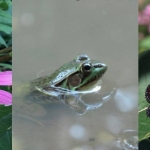What's Your Nature?
Become a Nature Up North explorer to share your encounters with wild things and wild places in New York's North Country. Post your wildlife sightings, landscape shots, photos from your outings, and even your organization's events!
Just Our Nature - news, updates and insights
Water Wellness

By Paul J. Hetzler on
Blog: Just Our NatureIf you don’t plan to send your water to college, why bother having it tested? Academic testing is in fact akin to water testing in the sense that they both can involve many diverse “subjects,” and that a passing grade in one department does not apply to other domains.
Everyone knows that taking an algebra exam won’t determine your grade in anthropology, history or theatre class. But it isn’t as…
2017 Nature Up North Calendars

By Jacob Malcomb on
Blog: Just Our NatureWe are pleased to announce that 2017 Nature Up North calendars are on sale. Our calendars feature some of our favorite photos that local folks have shared as Encounters on natureupnorth.org in the past year. They also feature Nature Notes highlighting interesting wildlife behavior to look out for each month. They make a great holiday gift!
Proceeds from our calendar sales benefit Nature Up…

Star Photography

By nick zachara on
Blog: Just Our NatureFor the past year I’ve been experimenting with night sky photography. I'm originally from suburban New Jersey, which is incredibly unfavorable for star photography -- you can hardly see the stars due to light pollution. But the clarity and perfection of the night sky around Canton, and near my family's camp in North Creek, inspired me to try capturing it on camera.
In October 2015, at our…
Don't Get Ticked This Fall

By Paul J. Hetzler on
Blog: Just Our NatureEven though I was born and raised in New York State, I never cease to be awestruck by the beauty of our changing seasons, and cannot imagine living in a place where the years pass with scant visible change in the environment. Yet there is one season I cannot abide, and it has arrived with a vengeance: hunting season.
Mind you, I have no problem with safety-trained folks traipsing through the…
Ask a Fairy Part 2: Fairy Food, Autumn Leaves, and Migration

By Thimble & Blossom on
Blog: Ask a FairyOur fairy friends Thimble Hickory and Blossom Dewdrop are back to answer the rest of your questions about North Country nature and the lives of fairies. While they're settled into the warmth of the tropics for winter, they're already excited to return to Canton, NY next fall!
Click here to read Thimble and Blossom's responses in Part 1.
Why do tree leaves change color? (Lucy,…
Ask a Fairy Part 1: Introducing Blossom and Thimble

By Thimble & Blossom on
Blog: Ask a FairyEach year a group of migrating group of woodland fairies passes through Canton on its way south for the winter. Woodland fairies know all the North Country plants and animals, and this year they invited us to visit their houses and ask questions about North Country nature. If you were walking along the Kip Trail, exploring Heritage Park, or running through the Remington Recreation Trail last…
North Country Voices: Joel Howie

By Amanda Brooks on
Blog: North Country VoicesJoel Howie is the owner of Canton Apples, a U-Pick apple orchard located on the corner of Barnes Road and County Road 25. He is originally from Rochester, NY, but moved to Canton in 2002 with his wife, Becky. Joel loves working outside all day long alongside his workers and friends and family who come to help out, and it shows in the quality of his product and the atmosphere on the orchard from…







Winter Is Coming: A Tale of Three North Country Species

By Lizz Muller on
Blog: Just Our NatureCome fall, we all start to prepare for winter in our own ways. We unearth the sweaters that have been accumulating dust since spring, and pull out our wool hats and mittens. Some of us chop wood and stack it next to the door, or restock the storm candles in the drawer by the stove. We can food, stocking pantry shelves with jars of red tomatoe sauce, purple sauerkraut, green dilly beans.…
The Great Blackbird Migration

By Paul J. Hetzler on
Blog: Just Our NatureMigrating birds of all stripes—and wing patches, tail bands, and other markings—are impressive. My hat is off (figuratively only, of course) to all the songbirds, raptors, and waterfowl that fly from their Northern breeding grounds to warmer climes, in some cases thousands of miles, without benefit of Google Maps or a travel agent.
Hummingbirds weighing about the same as a handful of paper clips…


Whitewater Kayaking on the Raquette

By Amanda Brooks on
Blog: Just Our Nature
Kayakers from all over the Eastern US and Canada convened at Stone Valley in Colton on Labor Day Weekend for the Raquette Race, part of the Whitewater King of New York Series. The series includes competitions along four Northern New York Rivers: the Raquette, Black, Beaver, and Moose.
The Raquette section of the race is a Class 5 rapids, the most challenging of the Whitewater King of New York…
